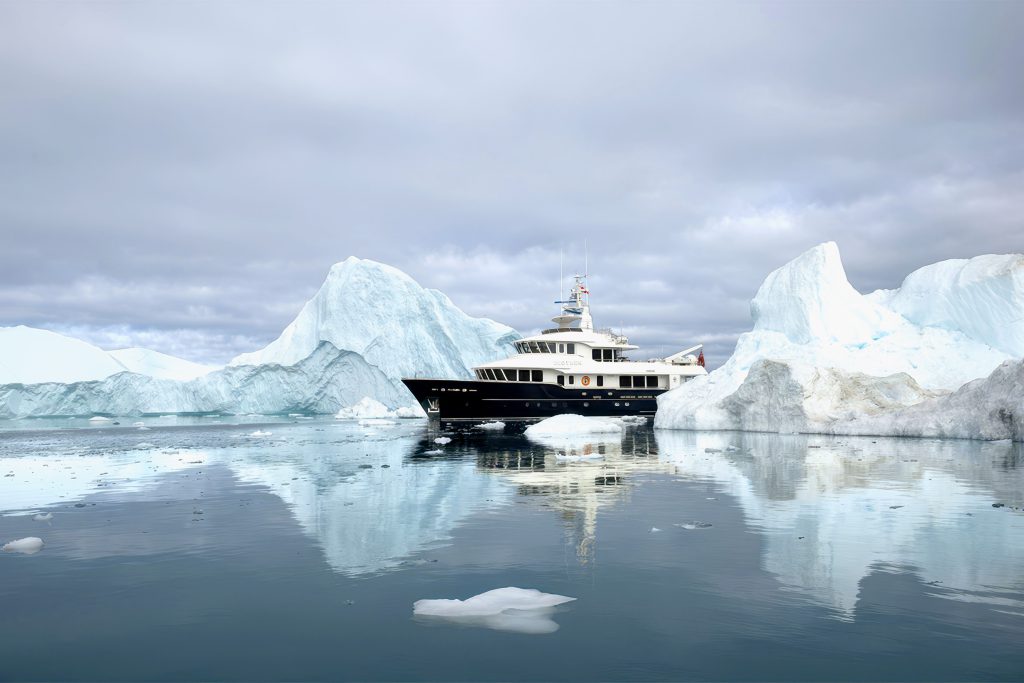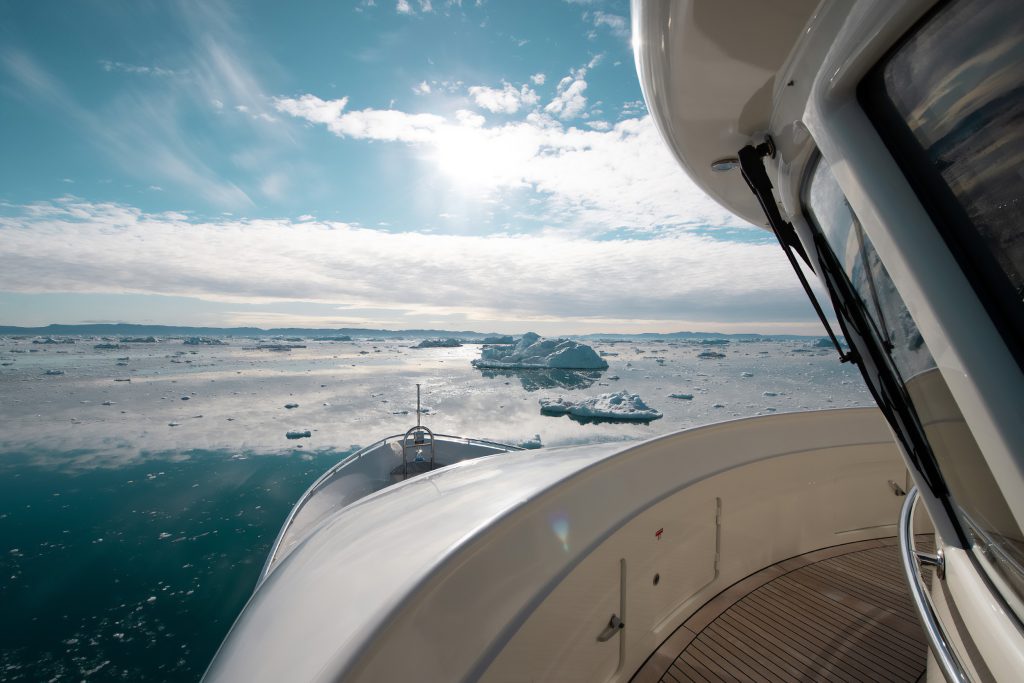
The journey so far
The evolution of a
Since its launch in 1968, the Doggersbank explorer has more than proven itself. The original design, with a steel hull and aluminium superstructure, is renowned for its no-nonsense innovation and excellent seaworthiness.
The round bilge displacement hull provides large interior volume for accommodation, storage and systems access. It’s what makes a Doggersbank the perfect platform for long-range exploration. The robust exterior is designed to behave well in all seafaring conditions. The high bow with a typical backwards bulwark provides a safe working deck. The heavy onboard equipment, such as anchor winches, stabilisers, cranes, hatches and doors, guarantees the boat’s reliability when sailing in remote areas.
The interior layout is conceived to give guests all the space and comfort needed to enjoy being onboard for long periods, including oceangoing passages and remote cruising. To this point, the owner’s stateroom is positioned in the most comfortable location on board – the lower deck aft
1961-1971
The first years
Dick Boon founded Vripack in 1961. In its early years, the company designed motor and sail-driven yachts up to 12m. The first Doggersbank, built in the Netherlands in 1968 for a Dutch owner, measured 10.8m in length. It was displayed at the Dutch National Boat Show a year after its delivery and generated great interest and future orders.
In 1971, a Dutch owner ordered his first Doggersbank, a 14.8m model. Three years later he ordered his second, a 19m model. This became the largest model in the Doggersbank fleet at the time.
Since the early years, more than 500 Doggersbank models have been built.






1971-1981
Growing the model line
In 1974, a 19.3m model became the largest Doggersbank of this decade, not to mention the largest yacht ever displayed at HISWA at that point. The same year, a 15.25m low displacement round bilge hull form (LDL) Doggersbank was designed and built for a repeat client. Constructed in lightweight polyester (GRP) it reached a top speed of 18 knots and was the first of two GRP models. To this day, they remain the only two Doggersbanks ever built in polyester.
Most Doggersbank models sport a double shaft line and multiple redundant systems. During the 70s and 80s, these features were innovations rarely seen in the yachting industry but were used by Vripack to enhance the safety aspect of the Doggersbank explorer.
It was around this time that Dick Boon began to implement the use of fin stabilisers, which complement the round bilge steel hull of the Doggersbank design. It resulted in a direct increase in the level of onboard comfort – another seismic improvement to the overall guest experience.
1981-1991
Going international
Two years later the first Doggersbank Offshore was developed for a US buyer. Built in Holland, the 25.6m Kathleen was the first model to enjoy Lloyd’s hull certification and a counterweight stabilisation system. This was later replaced with zero-speed stabilisation during her 2015 refit.
Impressed by Kathleen, a second US client placed an order for a 27.4m Doggersbank Offshore. Built in 1991 at Palmer Johnson in Sturgeon Bay she was the first Doggersbank constructed outside of the Netherlands. Meanwhile, demand for the traditional Doggersbank continued apace, with all other boats built in the Netherlands.
In 1990, the start of computer-assisted yacht design marked the beginning of a new era.






1991-2001
The Doggersbank offshore years
Gradually, over the course of the ’90s, the traditional Doggersbank model was phased out and replaced by the Offshore design. Various 25.6m models followed, as well as a smaller 20m Doggersbank and the largest yet, a 28.6m model, again for a US Owner.
The Doggersbank exterior and interior style also evolved. This was exemplified by a 29m model named Patriot, which was built in Holland in 2009. Patriot received a fresh, modern look and feel across its styling, finishes and systems.
Then came another milestone, the construction of two Doggersbank Offshores – a 27.4m and 28m – which were built on the same platform in Holland. The 27m model resided in New Zealand and made extensive voyages across the Pacific Ocean.
2001-2011
Enlarging the Doggersbank offshore
Beothuk is the largest Doggersbank Offshore to date and is defined by its rugged explorer exterior. Crucially, it was the first to complete the gruelling Northwest Passage, underlying the extreme capabilities of the enduring Doggersbank design.






2011-present
Revival of the brand
In 2011, Dutch shipyard Moonen signed a contract to build a 30m Doggersbank Offshore, which was launched in 2012. Three years later, in 2015, Kathleen underwent her refit, which saw her fully dismantled at a shipyard in San Diego and install a new interior designed by Vripack. Her refit, which included a systems overhaul and an exterior paint job, would win her an International Superyacht Society Refit Award.
In 2018, Gayle Force (ex-Patriot) underwent a considerable refit to prepare the yacht for an Arctic voyage. Gayle Force has since circumnavigated the world, extensively cruising the wilds of Patagonia and Alaska.
In 2020, Altena, the original Doggersbank shipyard in the Netherlands, signed a contract for a 20m new build for a new client, 18 years since its previous. The boat launched in early 2022, with a second hull ordered in quick succession.
And so, the Doggersbank story continues…
Worldwide
recognition
It is always an honour to have the ingenuity and innovation of the Doggersbank design acknowledged by esteemed bodies around the world, but it also gives recognition to the respective owners’ ambitions and contributions to the craft of yacht building. Each yacht is the result of two to three years of dedication on the part of the team, builders and owner, all of whom are united in a common goal; To build the best.
International Superyacht Society
Design Awards
MINNOW (ex KATHLEEN)
82’ Doggersbank Explorer (25m)
Refit Award
Finalist, 2015
Showboat
Design Awards
BEOTHUK
102’ Doggersbank Offshore (31m)
Best Motor Yacht below 500GT
Second, 2009
International Superyacht Society
Design Awards
COMMERCIAL BREAK
92’ Doggersbank Bradford Offshore (28m)
Best Motor Yacht 23m-32m
Finalist, 2004
International Superyacht Society
Design Awards
MAVERICK (ex ALEXA S)
93’ Doggersbank Offshore (28,3 m)
Best Motor Yacht 23-32m
Finalist, 2003